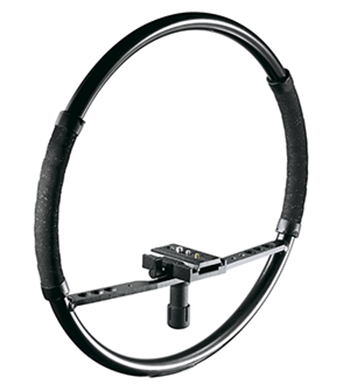Freeform Techniques Documentation
Fig Rig
Simply put, a Fig Rig is like a detached steering wheel for the video camera. The circular Fig Rig offers side grips and steady frame for manipulating the pathway of the camera. Videographers may firmly grip the Fig Rig on each side, creating resistance that promotes a steady transference of motion. Having the camera mounted perpendicular to the plane of the Fig Rig’s circular design also provides a spatial reference for the camera’s view and decreases the need for an eyepiece or display monitor. The Fig Rig is great for wheeling actions in the frontal plane and transverse camera movement.


Hand-held
Shooting video utilizing hand-held techniques can lead to the purest translation of motion from the body to the screen. Working directly with the camera, rather than through some other apparatus, can lead to a world of creative possibilities, although this approach also comes with its challenges and limitations. Hand-held videography is a great way to generate footage shot from spatially limited vantage points where movement restrictions may prevent the use of larger accessories. It is recommended that the videographer experiment with various grips on the camera to determine the most comfortable, safe, and functional way of supporting the camera. Without the benefits of spatial orientation experienced with the Fig Rig and the fluidity found when using the Glidecam, the videographer is required, more than ever, to partner the camera with heightened awareness and sensitivity. Hand-held techniques are often used to provide a more casual, natural effect with less formalized motion than one might experience when using a tripod or other support. Video filters have even been created to add a hand-held effect during post-production editing.
Duet Improvisation
Duet Improvisation
GlideCam
The Glidecam is described as “a lightweight, hand-held, camcorder stabilizing system which works so well that it allows you to shoot incredibly smooth and graceful shots even while going to extremes like running up and down stairs or traveling over rugged terrain…your camcorder seems to float, always balanced, isolated from your hands undesirable motions.” Balancing a camera on a Glidecam can be a little tricky and time consuming as it makes use of free weights to counterbalance the weight of the camera. Glidecams are available in a number of models and may involve harnesses, braces, and other supports for mounting the apparatus to the body. The Glidecam is ideal for camera movement in the horizontal plane.
Link to http://www.glidecam.com/
Link to http://www.glidecam.com/
The types of camera motion discussed above deal primarily with the logistics of how the camera is mounted and where in space the camera is moving. No matter the type of camera motion, it is crucial to take into consideration other elements of movement, particularly the use of time and energy. These performance issues are addressed further in the Transferring Energy section.